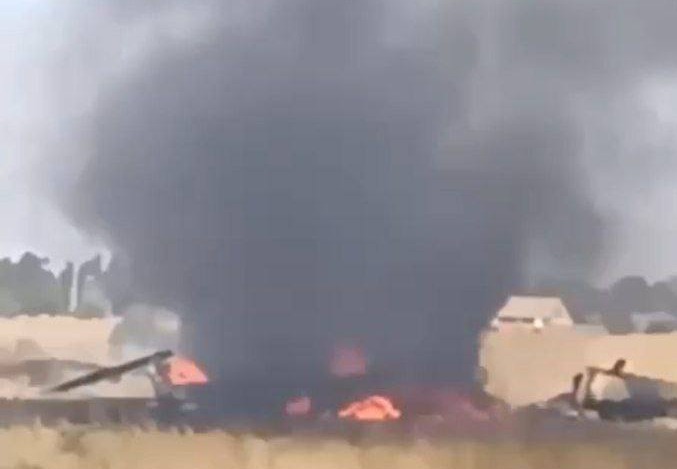On July 31, several pro-war Russian military Telegram channels announced that a Ukrainian drone had downed a Russian Mi-8 helicopter close to the capital of Ukraine’s eastern Donetsk region, an area known for fierce confrontations between Russian and Ukrainian forces.
Some channels claimed that this could be the first instance of Ukrainian forces successfully using a drone to target and down a Russian helicopter.
Well-known Russian war correspondent Boris Rozhin detailed that the Ukrainian forces “caught” the Mi-8 as it was taking off using an unmanned aerial vehicle (UAV). This occurrence reportedly took place at a considerable distance from the frontline.
The aircraft that crashed was part of the Russian National Guard’s aviation unit. The incident led to the deaths of the crew, with the likelihood that all passengers also perished in the incident.
The Russian Ministry of Defence has not commented on these reports till this report was filed, nor has Ukraine’s military command acknowledged carrying out such an operation.
🚁/1. Russian sources associated with Russian military aviation report that a Russian Mi-8 helicopter crashed/was downed near Donetsk. No information regarding the crew yet. pic.twitter.com/onNuq0Pbrt
— Special Kherson Cat 🐈🇺🇦 (@bayraktar_1love) July 31, 2024
However, the Fighterbomber Telegram channel, known to be connected to the Russian Aerospace Forces, confirmed the incident, stating, “This is true about the Mi-8. Unfortunately.”
The Fighterbomber channel further elaborated, “The enemy hit our Mi-8 near Donetsk. Sources confirm the information that on the territory of the [so-called Democratic People’s Republic] DPR, the enemy, using kamikaze drones, hit our Mi-8 helicopter. Unfortunately, the enemy is adapting, and this is not very good news for us. There were wounded soldiers on board. However, army aviation continues its work.”
Reports indicated that the helicopter was on a mission to evacuate the wounded. Conflicting reports exist about how it was brought down; some suggest it was due to friendly fire, while others point to a HIMARS rocket system as the cause.
Prominent Ukrainian journalist Yurii Butusov emphasized the potential significance of this incident, stating that if the drone involvement was confirmed, “then it’s a historic achievement worthy of Ukraine’s highest awards.”
He stated on Telegram that the entire crew and passengers were eliminated. He mentioned that the cost of the Mi-8 helicopter was no less than $15 million.
Butusov also said, “Previously, the Ukrainians had repeatedly published videos of unsuccessful attempts to intercept helicopters on the front line, but for the first time, an interception was announced where the enemy did not expect it, at a rear airfield.”

Drone Threats To Russian Helicopters
During the last two years of conflict, Ukrainian drone operators have greatly honed their skills, becoming exceptionally adept at pinpointing and targeting the vulnerabilities in Russian military equipment.
They have demonstrated their ability to fly drones into the open hatches of armored personnel carriers, slip under the additional armor of “turtle tanks,” and penetrate the doors of fortified infantry dugouts with remarkable precision.
‘Raptor Salad’ For Lunch! US F-22 Raptor Outgunned, Outmaneuvered By German Eurofighter Typhoon?
Ukraine has been persistently working to strike Russian military helicopters using drones. Ukraine is rapidly expanding its fleet of drone-on-drone interceptors to enhance its capabilities, which can also be deployed against rotary-wing aircraft.
FPV (First Person View) drones, especially those equipped with an aerial relay system, can effectively target slow-moving helicopters located up to 12 miles behind the front lines.
The development of using drones to target helicopters, while significant and potentially groundbreaking, is not particularly surprising. A man-in-the-loop controlled drone can strike a helicopter, particularly during its most vulnerable phase: the terminal stages of flight.
During this period, helicopters fly at low altitudes and reduced speeds, which makes them vulnerable targets, particularly in combat areas and close to the front lines.

The efforts to ram drones into Russian helicopters mid-flight date back to September 2023. The escalating threat posed by these drones prompted the Russian Air Force to assign escort helicopters to protect their airborne assets.
It took at least ten months of attempts before a Ukrainian drone operator successfully hit a Russian helicopter. This prolonged effort is understandable, given that helicopters can fly at a very high speed and altitudes of several thousand feet. Hitting a moving target under these conditions requires exceptional skill or significant luck.
Aware of the increasing threat from Ukrainian drones, Russia has begun implementing countermeasures to safeguard its helicopter fleet. According to a report in the EurAsian Times, the Russian Army Aviation is formulating new tactics for helicopter pilots to counter kamikaze drone attacks effectively.
Pilots are being trained to perform precise maneuvers to evade drone attacks. The primary approach involves a combination of evasive maneuvers and leveraging helicopters’ speed advantages.
- Contact the author at ashishmichel(at)gmail.com
- Follow EurAsian Times on Google News




